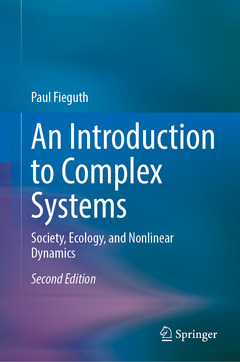Description
An Introduction to Complex Systems (2nd Ed., 2nd ed. 2021)
Society, Ecology, and Nonlinear Dynamics
Author: Fieguth Paul
Language: English
Subjects for An Introduction to Complex Systems:
Approximative price 63.29 €
In Print (Delivery period: 15 days).
Add to cart463 p. · 15.5x23.5 cm · Hardback
Description
/li>Contents
/li>Biography
/li>Comment
/li>
Complex Systems lie at the heart of a variety of large-scale phenomena of great significance - global warming, ice ages, water, poverty, pandemics - and this text uses these case studies as motivations and contexts to explore complex systems and related topics of nonlinear dynamics and power-law statistics. Although detailed mathematical descriptions of these topics can be challenging, the consequences of a system being nonlinear, power-law, or complex are in fact quite accessible. This book blends a tutorial approach to the mathematical aspects of complex systems together with a complementary narrative on the global/ecological/societal implications of such systems.
Nearly all engineering undergraduate courses focus on mathematics and systems which are small scale, linear, and Gaussian. Unfortunately there is not a single large-scale ecological or social phenomenon that is scalar, linear, and Gaussian. This book offers insights to better understand the large-scale problems facing the world and to realize that these cannot be solved by a single, narrow academic field or perspective. Instead, the book seeks to emphasize understanding, concepts, and ideas, in a way that is mathematically rigorous, so that the concepts do not feel vague, but not so technical that the mathematics get in the way. The book is intended for students in technical domains such as engineering, computer science, physics, mathematics, and environmental studies.
This second edition adds nine new examples, over 30 additional problems, 50 additional figures, and three new chapters offering a detailed study of system decoupling, extensive solutions to chapter problems, and a timely discussion on the complex systems challenges associated with COVID-19 and pandemics in general.
1 Introduction.- 2 Global Warming and Climate Change.- Further Reading.- 3 Systems Theory.- 3.1 Systems & Boundaries.- 3.2 Systems & Thermodynamics.-3.3 Systems of Systems.- Case Study 3: Nutrient Flows, Irrigation, and Desertification.- Further Reading.- Sample Problems.- 4 Dynamic Systems.- 4.1 System State.- 4.2 Randomness .-4.3 Analysis.-4.3.1 Correlation.-4.3.2 Stationarity.- 4.3.3 Transformations.- Case Study 4: Water Levels of the Oceans and Great Lakes.- Further Reading.- Sample Problems.- 5 Linear Systems.- 5.1 Linearity.- 5.2 Modes.-5.3 System Coupling.- 5.4 Dynamics.- 5.5 Non-Normal Systems.- Case Study 5: System Decoupling.- Further Reading.- Sample Problems.- 6 Nonlinear Dynamic Systems – Uncoupled.- 6.1 Simple Dynamics.- 6.2 Bifurcations.- 6.3 Hysteresis and Catastrophes.- 6.4 System Behaviour near Folds.- 6.5 Overview.- Case Study 6: Climate and Hysteresis.- Further Reading.- Sample Problems.- 7 Nonlinear Dynamic Systems – Coupled.-7.1 Linearization.- 7.2 2D Nonlinear Systems.- 7.3 Limit Cycles and Bifurcations.- Case Study 7: Geysers, Earthquakes, and Limit Cycles.- Further Reading.- Sample Problems.- 8 Spatial Systems.- 8.1 PDEs.- 8.2 PDEs & Earth Systems.- 8.3 Discretization.- 8.4 Spatial Continuous-State Models.- 8.5 Spatial Discrete-State Models.- 8.6 Agent Models.- Case Study 8: Global circulation models.- Further Reading.- Sample Problems.- 9 Power Laws and Non-Gaussian Systems.- 9.1 The Gaussian Distribution 9.2 The Exponential Distribution .- 9.3 Heavy Tailed Distributions.- 9.4 Sources of Power Laws.- 9.5 Synthesis and Analysis of Power Laws.- Case Study 9: Power Laws in Social Systems.- Further Reading.- Sample Problems.- 10 Complex Systems.- 10.1 Spatial Nonlinear Models.- 10.2 Self-Organized Criticality.- 10.3 Emergence.- 10.4 Systems of Complex Systems.- Case Study 10: Complex Systems in Nature.- Further Reading.- Sample Problems.- 11 Observation & Inference.- 11.1 Forward Models.- 11.2 Remote Measurement.- 11.3 Resolution.-11.4 Inverse Problems.- Case Study 11A: Sensing— Synthetic Aperture Radar.- Case Study 11B: Inversion— Atmospheric Temperature.- Further Reading.- Sample Problems.- 12 Water.- 12.1 Ocean Acidification.- 12.2 Ocean Garbage.- 12.3 Groundwater.- Case Study 12: Satellite Remote Sensing of the Ocean.- Further Reading.- Sample Problems.- 13 Pandemics and Complex Systems.- 13.1 Pandemic Dynamics.- 13.2 Pandemic Models.- 13.3 Pandemic Anticipation.- Case Study 13: Pandemic Inverse Problems and Inference.- Further Reading.- Sample Problems (Partial Solutions in Appendix E).- 14 Concluding Thoughts.- Further Reading.- Part I Appendices.- A Matrix Algebra.- B Random Variables and Statistics.- C System Decoupling.- D Notation Overview.- E End of Chapter Solutions.- Index.
Paul Fieguth is a professor in Systems Design Engineering at the University of Waterloo in Ontario, Canada. He has longstanding research interests in statistical signal and image processing, hierarchical algorithms, machine learning, and the interdisciplinary applications of such methods, particularly to problems in medical imaging, remote sensing, and scientific imaging. With Springer he has published two successful books: Statistical Image Processing and Multidimensional Modeling (2011) and An Introduction to Complex Systems (2017, 1st edition).
Offers an interdisciplinary approach, aimed at connecting the dots between the underlying physics/mathematics and macroscopic world-scale phenomena
Focuses on complex systems, with chapters dedicated to interacting, large scale, nonlinear and non-Gaussian systems
Provides ecologically and socially motivated case studies to offer substantial real-world context and motivation to the technical contents
Enriched with dozens of examples, boxed inserts and formulas, as well as over 300 illustrations
Over 100 end-of-chapter problems, most with solutions, spanning the full range of conceptual, analytical, computational, reading/essay and policy-related questions
Self-contained, with appendices giving an overview of the needed mathematical and conceptual background

